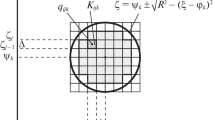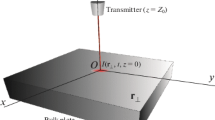A study has been made of the process of heating of an inhomogeneous solid body by laser radiation, that is described by a one-dimensional parabolic equation with a volume heat source. The inverse problem of determining the law of variation in the density of laser-radiation power with the depth of the solid body has been posed. The temperature distribution through the body′s depth at a certain fixed instant of time was used as the supplementary condition. A discrete analog of the posed problem has been constructed with finite-difference approximations. To solve the obtained difference problem, a special representation was proposed which allows splitting this problem into two mutually independent difference problems. As a result, an explicit formula has been obtained from which the law of variation in the density of laser-radiation power with the depth of the solid body is restored.
Similar content being viewed by others
References
N. N. Rykalin, A. A. Uglov, I. V. Zuev, and A. N. Kokora, Laser and Electron-Beam Treatment of Metals [in Russian], Mashinostroenie, Moscow (1985).
N. B. Delone, Interaction of Laser Radiation with the Substance [in Russian], Nauka, Moscow (1989).
M. N. Libenson, E. B. Yakovlev, and G. D. Shandybina, Interaction of Laser Radiation with the Substance. Part II. Laser Heating and Failure of Materials [in Russian], NIU ITMO, St. Petersburg (2014).
Yu. M. Klimkov, V. S. Maiorov, and M. V. Khoroshev, Interaction of Laser Radiation with the Substance [in Russian], MIIGAiK, Moscow (2014).
V. T. Borukhov and G. M. Zayats, Identification of a time-dependent source term in nonlinear hyperbolic or parabolic heat equation, Int. J. Heat Mass Transf., 91, 1106–1113 (2015).
A. A. Samarskii and P. N. Vabishchevich, Numerical Methods for Solving Inverse Problems of Mathematical Physics, Walter de Gruyter, Berlin (2008).
P. N. Vabishchevich, Computational identification of the lowest spacewise dependent coefficient of a parabolic equation, Appl. Math. Model, 65, 361–376 (2019).
P. N. Vabishchevich, Iterative computational identification of a spacewise dependent source in parabolic equation, Inv. Probl. Sci. Eng., 25, No. 8, 1168–1190 (2017).
K. Cao and D. Lesnic, Reconstruction of the space dependent perfusion coefficient from final time or time average temperature measurements, J. Comput. Appl. Math., 337, 150–165 (2018).
K. Cao and D. Lesnic, Simultaneous reconstruction of the perfusion coefficient and initial temperature from time average temperature measurements, Appl. Math. Model., 68, 523–539 (2019).
Kh. M. Gamzaev, S. O. Huseynzade, and G. A. Gasimov, Numerical method to solve identification problem for the lower coefficient and the source in the convection-reaction equation, Cyb. Syst. Anal., 54, No. 6, 971–976 (2018).
T. Johansson and D. Lesnic, Determination of a spacewise dependent heat source, J. Comput. Appl. Math., 209, 66–80 (2007).
K. R. Aida-zade and A. B. Rahimov, An approach to numerical solution of some inverse problems for parabolic equations, Inv. Probl. Sci. Eng., 22, No. 1, 96–111 (2014).
A. G. Fatullayev and S. Cula, An iterative procedure for determining an unknown spacewise-dependent coefficient in a parabolic equation, Appl. Math. Lett., 22, 1033–1037 (2009).
V. A. Morozov, Methods of Regularization of Unstable Problems [in Russian], Izd. Moskovsk. Univ., Moscow (1987).
O. M. Alifanov, E. A. Artyukhin, and S. V. Rumyantsev, Extreme Methods for Solving Ill-Posed Problems with Applications to Inverse Problems, Begell House, New York (1995).
Author information
Authors and Affiliations
Corresponding author
Additional information
Translated from Inzhenerno-Fizicheskii Zhurnal, Vol. 96, No. 5, pp. 1135–1141, September–October, 2023.
Rights and permissions
Springer Nature or its licensor (e.g. a society or other partner) holds exclusive rights to this article under a publishing agreement with the author(s) or other rightsholder(s); author self-archiving of the accepted manuscript version of this article is solely governed by the terms of such publishing agreement and applicable law.
About this article
Cite this article
Gamzaev, K.M. Numerical Solution of the Inverse Problem of Heating of a Solid Body by Laser Radiation. J Eng Phys Thermophy 96, 1128–1133 (2023). https://doi.org/10.1007/s10891-023-02777-y
Received:
Published:
Issue Date:
DOI: https://doi.org/10.1007/s10891-023-02777-y




